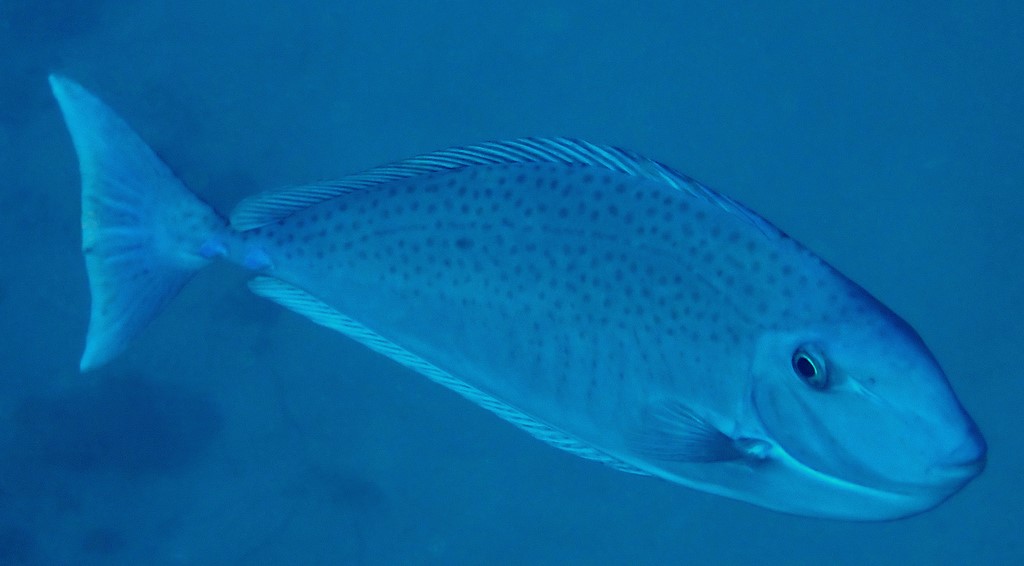NASO MACULATUS - (RANDALL & STRUHSAKER, 1981)
Picture courtesy of: Alain Daoulas
Actinopterygii (Gigaclass) > Actinopteri (Class) > Teleostei (Subclass) > Acanthuriformes (Order) > Acanthuridae (Family) > Naso (Genus)
Scribbled unicornfish, Goma-tenguhagi-modoki, ゴマテングハギモドキ, 剥皮仔, 班鼻魚,
Description
Dorsal spines (total): 6-7; Dorsal soft rays (total): 26-28; Anal spines: 2; Anal soft rays: 26-28; Pectoral fin rays: 16-18; Pelvic fin rays: I, 3; Caudal fin (branched rays): 14; Gill rakers short: 3-4 + 10-12; Vertebrae: 9 + 13. Body elongate, dorsal and ventral profiles of head evenly convex, forehead without rostral prominence even in adults; Deep diagonal groove on snout from eye towards anterior end of snout. Two small peduncular plates each with a sharp, approximately semicircular, laterally projecting keel. Caudal fin emarginate without a filament. Max. length: 60.0 cm TL. Depth range: 20 - 220 m.
Color
A bluish-grey unicornfish becoming paler below, with small dark spots and short lines on the upper ¾ of body and caudal fin, similar but less distinct and less dense spots on the head, and a dark line along the lateral line that breaks up into spots posteriorly.
Etymology
Naso: from Latin, nasus = nose. Referring to “protuberance in the shape of a horn or a large magnifying glass on the nose” (translation, actually forehead) on adults of Naso fronticornis (= unicornis).
maculatus: from Latin, maculatus = stain, make spotted. Referring to numerous dark spots on both juveniles and adults.
Original description: Naso maculatus Randall & Struhsaker, 1981 - Type locality: Northern shore off Haleiwa, Oahu Island, Hawaiian Islands, 21°40'N, 158°07'W, depth 100 meters.
Distribution
Eastern Indian Ocean, western and central Pacific: Western Australia to Indonesia; East China Sea to Japan and Hawaiian Islands; Lord Howe Island, Chesterfield Islands, Grande Terre Group and Loyalty Islands (New Caledonia).
Biology
Found in deep seaward reefs. Benthopelagic and mesopelagic.
Last update: 8, May 2022
Actinopterygii (Gigaclass) > Actinopteri (Class) > Teleostei (Subclass) > Acanthuriformes (Order) > Acanthuridae (Family) > Naso (Genus)
Scribbled unicornfish, Goma-tenguhagi-modoki, ゴマテングハギモドキ, 剥皮仔, 班鼻魚,
Description
Dorsal spines (total): 6-7; Dorsal soft rays (total): 26-28; Anal spines: 2; Anal soft rays: 26-28; Pectoral fin rays: 16-18; Pelvic fin rays: I, 3; Caudal fin (branched rays): 14; Gill rakers short: 3-4 + 10-12; Vertebrae: 9 + 13. Body elongate, dorsal and ventral profiles of head evenly convex, forehead without rostral prominence even in adults; Deep diagonal groove on snout from eye towards anterior end of snout. Two small peduncular plates each with a sharp, approximately semicircular, laterally projecting keel. Caudal fin emarginate without a filament. Max. length: 60.0 cm TL. Depth range: 20 - 220 m.
Color
A bluish-grey unicornfish becoming paler below, with small dark spots and short lines on the upper ¾ of body and caudal fin, similar but less distinct and less dense spots on the head, and a dark line along the lateral line that breaks up into spots posteriorly.
Etymology
Naso: from Latin, nasus = nose. Referring to “protuberance in the shape of a horn or a large magnifying glass on the nose” (translation, actually forehead) on adults of Naso fronticornis (= unicornis).
maculatus: from Latin, maculatus = stain, make spotted. Referring to numerous dark spots on both juveniles and adults.
Original description: Naso maculatus Randall & Struhsaker, 1981 - Type locality: Northern shore off Haleiwa, Oahu Island, Hawaiian Islands, 21°40'N, 158°07'W, depth 100 meters.
Distribution
Eastern Indian Ocean, western and central Pacific: Western Australia to Indonesia; East China Sea to Japan and Hawaiian Islands; Lord Howe Island, Chesterfield Islands, Grande Terre Group and Loyalty Islands (New Caledonia).
Biology
Found in deep seaward reefs. Benthopelagic and mesopelagic.
Last update: 8, May 2022
